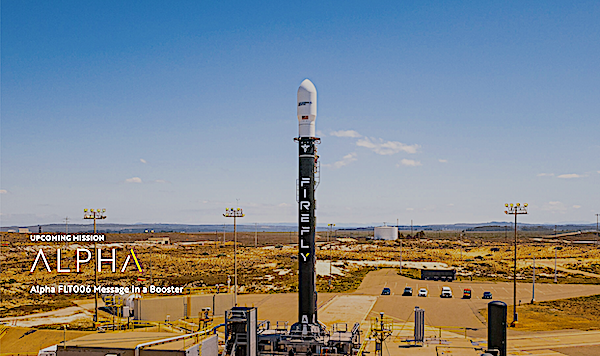
Firefly Alpha rocket experienced a launch anomaly that left a Lockheed Martin satellite in a significantly “lower than planned orbit”, and the “stage and its payload reentered over the South Pacific near Antarctica,” the aerospace company said on Tuesday, April 29. The mission originally planned for Monday was scrubbed due to unresolved ground support equipment issues.
A camera on the upper stage revealed debris falling away from the rocket seconds after separation, and the nozzle for the single Lightning engine in the upper stage appeared to be seriously damaged, or possible entirely gone.
This was the sixth flight of the Firefly Alpha small satellite launcher, launching the demonstration mission for Lockheed Martin’s new LM400 satellite bus, which carried a communications payload. The satellite bus is customizable to support different missions, including remote sensing, communications, imagery and radar Earth observations. It can also support different kinds of orbits and launch configurations.
In a statement four and a half hours after launch, Firefly confirmed that the upper stage and its payload failed to reach orbit because of the stage separation issue. “The rocket then experienced a mishap between stage separation and second stage ignition that led to the loss of the Lightning engine nozzle extension, substantially reducing the engine’s thrust,” the company stated.
The upper stage reached a peak altitude of 320 kilometers but did not achieve orbital velocity. The stage and its payload reentered over the South Pacific near Antarctica. “The team is working closely with our customers and the FAA to conduct an investigation and determine root cause of the anomaly,” the company stated.
Firefly’s statement:
April 29, 2025, 11 am PDT: Today, Firefly’s Alpha FLTA006 launch began with a nominal liftoff and progressed through first stage flight, reaching target separation velocity. The rocket then experienced a mishap between stage separation and second stage ignition that led to the loss of the Lightning engine nozzle extension, substantially reducing the engine’s thrust.
Initial indications showed Alpha’s upper stage reached 320 km in altitude. However, upon further assessment, the team learned the upper stage did not reach orbital velocity, and the stage and payload have now safely impacted the Pacific Ocean in a cleared zone north of Antarctica.
Firefly recognizes the hard work that went into payload development and would like to thank our mission partners at Lockheed Martin for their continued support. The team is working closely with our customers and the FAA to conduct an investigation and determine root cause of the anomaly. We will provide more information on our mission page after the investigation is completed.
April 29, 2025, 8 am PDT: Following a nominal liftoff of Firefly’s Alpha rocket, there was a mishap during first stage separation for the FLTA006 mission that impacted the Stage 2 Lightning engine nozzle. We are working with our Lockheed Martin customer, the Space Force, and FAA to conduct a thorough investigation and determine the root cause. As more information is available, we will be providing updates here.s.
Orbit off the mark
While liftoff and initial ascent appeared normal, trouble emerged roughly 2 minutes and 35 seconds into flight during stage separation.
Firefly Aerospace ready for Monday launch of Lockheed Martin’s FLTA006 Message in a Booster mission
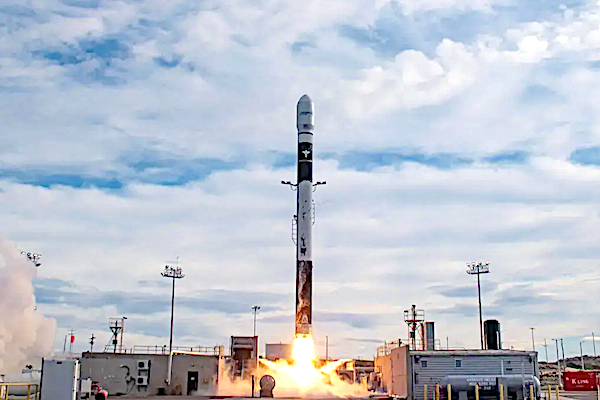
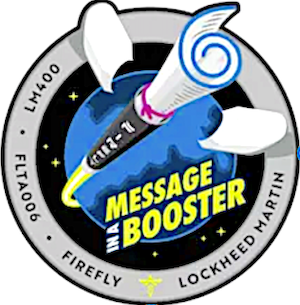
Firefly Aerospace’s launch of Lockheed Martin’s FLTA006 has now been scheduled for Monday, April 28th, at 6:37 AM -7:29 AM PDT from Vandenberg. Space Launch Complex 2W has launched 97 rockets, including 97 orbital launch attempts. While Vandenberg SFB, California, has been the site for 802 rocket launches.
Vandenberg Space Force Base is a United States Space Force Base in Santa Barbara County, California. Established in 1941, Vandenberg Space Force Base is a space launch base, launching spacecraft from the estern Range, and also performs missile testing.
This will be the sixth flight of the Firefly Alpha small satellite launcher, launching the demonstration mission for Lockheed Martin’s new LM400 satellite bus, which will carry a communications payload. The satellite bus is customizable to support different missions, including remote sensing, communications, imagery and radar Earth observations. It can also support different kinds of orbits and launch configurations.
Weather Forecast During Launch
The forecast calls for a temperature of 51°F, scattered clouds, 38% cloud cover and a wind speed of 12mph.
Firefly Aerospace now plans a Sunday launch of Lockheed Martin’s FLTA006 Message in a Booster mission

Firefly Aerospace’s launch of Lockheed Martin’s FLTA006 has been scheduled for Sunday, April 27th, at 6:37 AM – 8:17 AM PDT from Vandenberg.
This is the sixth flight of the Firefly Alpha small satellite launcher, launching the demonstration mission for Lockheed Martin’s new LM400 satellite bus that will carry a communications payload. The satellite bus is customizable to support different missions, including remote sensing, communications, imagery and radar Earth observations. It can also support different kinds of orbits and launch configurations.
Vandenberg Space Force Base is a United States Space Force Base in Santa Barbara County, California. Established in 1941, Vandenberg Space Force Base is a space launch base, launching spacecraft from the Western Range, and also performs missile testing. The United States Space Force’s Space Launch Delta 30 serves as the host delta for the base, equivalent to an Air Force air base wing. In addition to its military space launch mission, Vandenberg Space Force Base also hosts space launches for civil and commercial space entities, such as NASA and SpaceX.
The forecast calls for a temperature of 53°F, overcast clouds, 86% cloud cover and a wind speed of 9mph.
Firefly Aerospace’s launch of Lockheed Martin’s FLTA006 Message in a Booster mission is ‘to be determined’
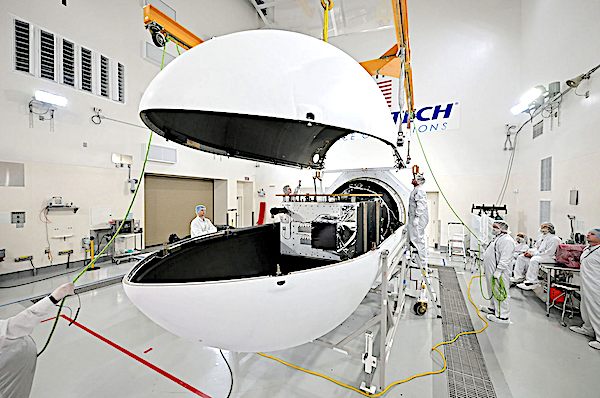
Firefly Aerospace’s launch of Lockheed Martin’s FLTA006 (Message in a Booster) from Space Launch Complex 2W, Vandenberg SFB, California, is yet to be determined.
Alpha FLTA006 is the second mission Firefly is launching for Lockheed Martin and the first of Firefly’s multi-launch agreement with Lockheed Martin that includes up to 25 missions over the next five years. This mission will launch Lockheed Martin’s LM 400 tech demo to prove out the risk-reduction and pathfinding efforts the company has done for its multi-mission satellite bus. Launching the mid-size satellite to low Earth orbit, FLTA006 will further validate Alpha’s robust performance to take customers directly to their preferred orbits as the only operational 1 metric ton rocket.
The LM 400 is Lockheed Martin’s most flexible and capable satellite platform with multi-mission capabilities that can be tailored for almost any mission, including remote sensing, communications, imaging and radar.
Firefly Aerospace’s Firefly Alpha to launch Lockheed Martin’s FLTA006 Message in a Booster mission on Friday



On Friday, April 18 Firefly Aerospace will launch FLTA006 (Message in a Booster) between 6:37 AM – 8:17 AM PDT Space Launch Complex 2W, Vandenberg SFB, California, at a cost of $15Million.
Firefly Aerospace is an American private aerospace firm based in Austin, Texas, that develops small and medium-sized launch vehicles for commercial launches to orbit.
The forecast calls for a temperature of 51°F, clear skies, 0% cloud cover and a wind speed of 14mph.
This launch will be the sixth flight of the Firefly Alpha small satellite launcher, launching the demonstration mission for Lockheed Martin’s new LM400 satellite bus, which will carry a communications payload. The satellite bus is customizable to support different missions, including remote sensing, communications, imagery and radar Earth observations. It can also support different kinds of orbits and launch configurations.
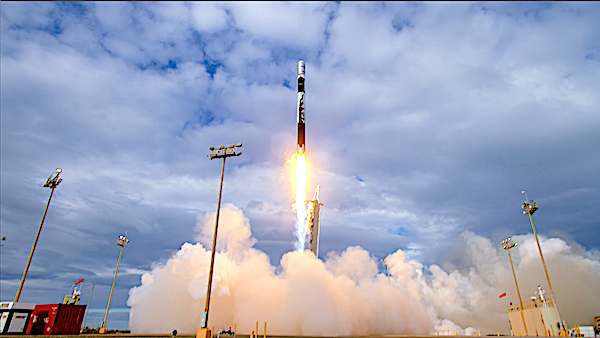
Alpha FLTA006 is the second mission Firefly is launching for Lockheed Martin and the first of Firefly’s multi-launch agreement with Lockheed Martin that includes up to 25 missions over the next five years. This mission will launch Lockheed Martin’s LM 400 tech demo to prove out the risk-reduction and pathfinding efforts the company has done for its multi-mission satellite bus. Launching the mid-size satellite to low Earth orbit, FLTA006 will further validate Alpha’s robust performance to take customers directly to their preferred orbits as the only operational 1 metric ton rocket.
The LM 400 is Lockheed Martin’s most flexible and capable satellite platform with multi-mission capabilities that can be tailored for almost any mission, including remote sensing, communications, imaging and radar.
Approximately the volume of an average home refrigerator and accommodating payloads up to 1,100kg, this mid-sized bus features exceptional propulsion and optimal operability in low Earth orbit (LEO), medium Earth orbit (MEO) and geosynchronous Earth orbit (GEO) compared to others in its class.
The demand for LM 400 plays an important role in the evolving Space industry. Space missions are adopting proliferated network architectures that use a multitude of smaller satellites in differing orbits to form a robust constellation, offering greater resilience in the face of threats or unforeseen anomalies. The LM 400 satellite platform provides a highly flexible bus foundation, resulting in rapid deployment at lower price points to help achieve the connectivity for data transport and missile warning and tracking operations.
FireFly Alpha Message in a Booster on hold launch to be determined
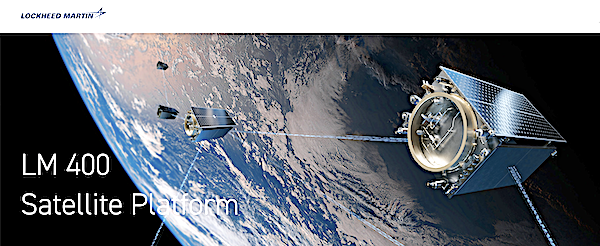
The projection of a Sunday launch of FireFly Alpha’s Message in a Booster has come and gone with no statement issued as to a new date. There is a possibility that April may be the month.
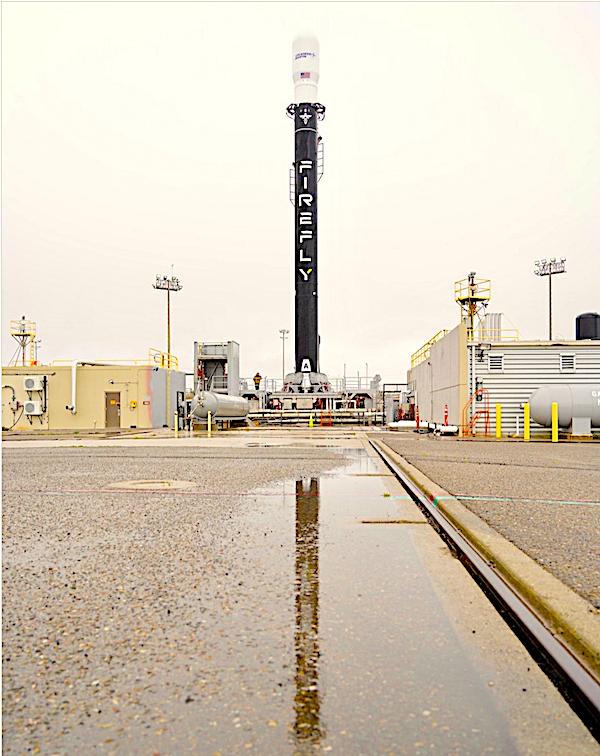
This will be the sixth flight of the Firefly Alpha small satellite launcher as a demonstration mission for Lockheed Martin’s new LM400 satellite bus, which will carry a communications payload.
Firefly Alpha’s Message in a Booster now booked for Sunday launch

The following is a statement issued on Vandenberg Rocket Launches Facebook page.
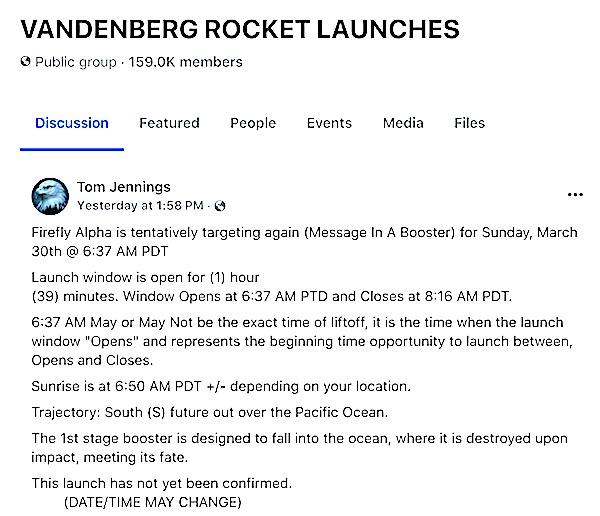
Firefly Alpha’s delay due to strong winds still waiting for window to launch
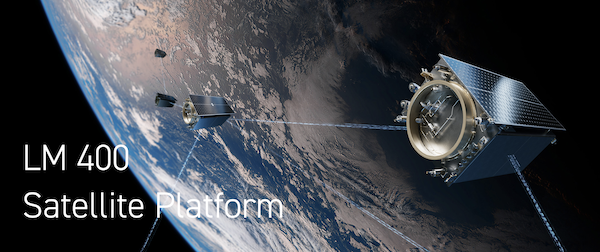
Firefly Alpha from Firefly Aerospace is scheduled to launch on March 26 from Space Launch Complex 2W at Vandenberg SFB at 6:37 – 8:17 am PDT, at a cost of $15 million, however….
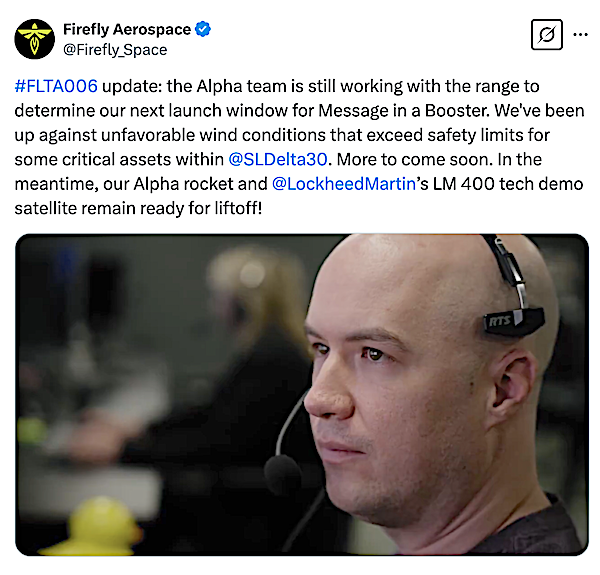
Firefly Alpha is ready to launch FLTA006 (Message in a Booster) on Wednesday

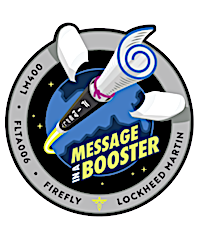
Firefly Alpha from Firefly Aerospace will launch on March 26 from Space Launch Complex 2W at Vandenberg SFB at 6:37 – 8:17 am PDT, at a cost of $15 million.
This is the sixth flight of the Firefly Alpha small satellite launcher, launching the demonstration mission for Lockheed Martin’s new LM400 satellite bus, which will carry a communications payload.

